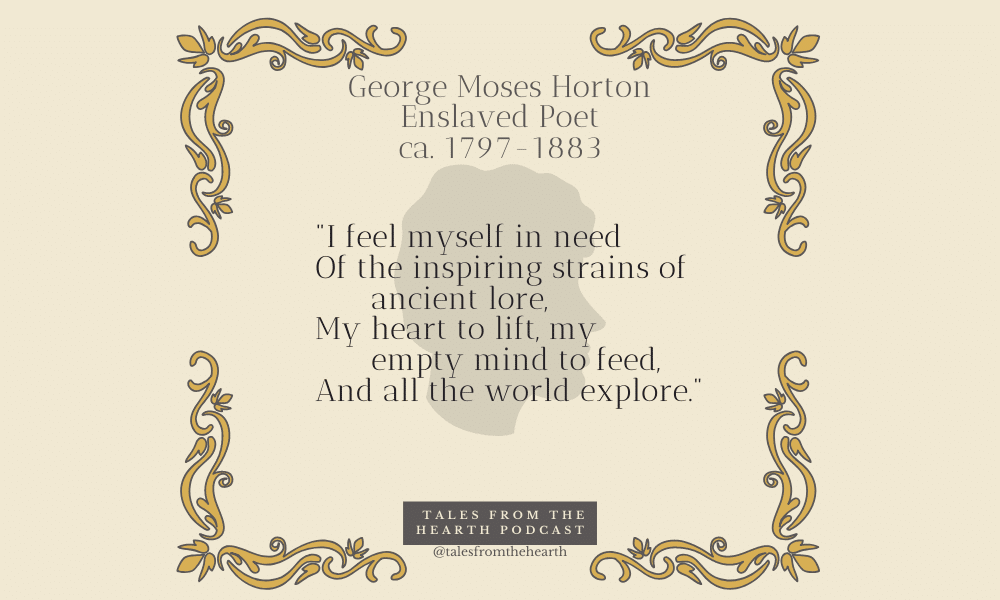George Moses Horton
ca. 1797-1883
Episode Intro: Did you ever hear of a poet who published a book before he had even learned how to write? How about a poet who published a book in the Southern U.S., WHILE he was still enslaved? Today’s story is about the amazing feats of poet George Moses Horton, who lived between 1797 and 1883.
Let’s get cracklin’, shall we?
**********
I was so close—yet so far away from poet George Moses Horton.
I grew up and unknowingly played in the former location of Horton’s enslavement near Pittsboro, North Carolina. I also attended nearby Horton Middle School, which was named to honor the poet when it was first established in the 1930s.
I knew the basic facts about Horton, of course: The first enslaved person to publish a book in the South, the only poet to publish a book before he had learned how to write, and although he lived apart from his owner and earned money for his poetry, he lived in slavery for sixty-eight years until he was liberated after the Civil War in 1865.
I never knew the gravity of what those basic facts meant, and what he accomplished, and the gift he gave to others who came after him. I’m excited to share that information with you today!
Sources for today’s story are: Many! As always, check out the episode show notes for all the links and references. You can also check out my Pinterest board titled “George Moses Horton” at https://www.pinterest.com/TalesfromtheHearth/george-moses-horton/ for more photos and links to more of Horton’s story.
There’s a great children’s book entitled Poet: The Remarkable Story of George Moses Horton by Don Tate
Another great resource is The Black Bard of North Carolina: George Moses Horton and His Poetry by Joan R. Sherman
Biographical information about Horton is sparse, and is mostly autobiographical found in Horton’s The Poetical Works of George M. Horton, The Colored Bard of North-Carolina, To Which Is Prefixed The Life of the Author, Written by Himself, published in 1845 (I will shorten that to The Poetical Works moving forward). This book and all of Horton’s works are now in the public domain, and you can find it and others on the University of North Carolina at Chapel Hill’s website (link in the episode show notes at www.talesfromthehearth.com).
I highly recommend the University’s link as a reliable resource, unlike many other links the Google results will display—they’re pretty unreliable. For example, if you google “George Moses Horton,” a photo of a man in a Union army uniform will appear. This man is Delany Martin, not George Moses Horton. There are no known photos of the poet. Nonetheless, I have linked this photo and the reference article identifying the man in the photo on my Pinterest board.
All of Horton’s poems are in the public domain, so I will be able to share and read a few of them with you today. I hope that you’re inspired and will want to share his story and read many more of his poems.
The ONE takeaway I hope you get from today’s story is: Almost ANYTHING can be accomplished with hard work.
I hope you enjoy today’s story about George Moses Horton.
**********
George Moses Horton was born in 1797 in Northampton County, North Carolina, close to the Roanoke River near the Virginia-North Carolina border. George was the sixth of ten children, eight girls and two boys. His owner was a tobacco farmer, William Horton, who was born in approximately 1737. In 1800 the Horton household relocated near the town of Pittsboro, North Carolina, located in Chatham County (in the center of the state). The household consisted of William and his son, five females, and eight slaves—George’s mother, five of George’s sisters, George, and another slave.
From a young age, George loved the idea of reading and words, but his learning was limited to what he could pick up from overhearing others reading and practicing the alphabet. His owner did not believe in the value of an education even for his own family, so George learned what he could and when he could from scraps of discarded paper and a Wesley hymnal. He also taught his younger brother what he knew. George didn’t know how to write, so the poems he created stayed in his memory.
Life was difficult for George as a slave, with hard labor and a plethora of alcohol available to him, courtesy of his owner.
In 1814 George became the property of William’s son, James. As James’s slave, he had more freedom, and in 1817 he traveled to nearby Chapel Hill every Sunday to sell fruit. At first, George struggled when he traveled to the University, finding himself the subject of tricks, pranks, and other rude behavior. George also noted in The Poetical Works of George M. Horton, The Colored Bard of North-Carolina, To Which Is Prefixed The Life of the Author, Written by Himself he abused alcohol during this time—a habit encouraged by his owner. It wasn’t long, however, before the students and other mockers noticed George’s intelligence, as he tended to give poetic replies to their hostilities. They brought him books and resources to learn more, and soon George was selling his acrostic love poems on a sliding scale per word—some bringing in close to seventy-five cents! An acrostic poem is a poem where letters in every line spell out another word or word(s) related to the poem. The most common type of acrostic poem is where the first letters of each line spell out a message.
George was able to support himself from the sale of his poetry and other miscellaneous work, and in the 1830s was able to buy his time from his owner and live in Chapel Hill. Although he was selling his poetry, he didn’t learn to write until around 1832. He relied upon dictating the poems to the buyer, who wrote down what he had composed.
In 1828 a professor’s wife, Caroline Lee Hentz, took George under her wing and taught him more advanced writing, reading, and grammar. She worked with her connections at the Lancaster Gazette (in Massachusetts) to get George’s very first poem, “Liberty and Slavery,” published on April 8, 1829.
After this, many had heard George’s story and conditions of enslavement, and worked to try to raise funds for his freedom and perhaps even to send him to Liberia. People such as the noted abolitionists Horace Greeley and William Lloyd Garrison, University of North Carolina presidents Joseph Caldwell and David Swain, and North Carolina’s Governor John Owen all tried to intercede on George’s behalf, but to no avail.
George’s owner, in an incredibly jerk move, kept raising the price requested for George, and even when Horton’s first book of poetry, The Hope of Liberty, was published, the profits weren’t enough to secure George’s release.
The Hope of Liberty was published by Joseph Gales out of Raleigh, NC, and was the first book published by a black enslaved man in the South.
George continued to buy his time from his owner and started a family some time between 1833 and 1843. He married a slave who belonged to Franklin Snipes, with whom he would have one son, Free, and one daughter, Rhody. It is unclear whether George Moses Horton has descendants today, and if they are still alive.
In 1843, George’s second owner, James, died. George thought he finally stood a chance at being liberated, but instead, his third owner, Hall Horton (James’s son), in a REAL jerk move, increased the price that George had to pay to “buy out his time.” George went back to work to publish another poetry collection to secure the funds for his release, and in 1845, The Poetical Works of George M. Horton, The Colored Bard of North-Carolina, To Which Is Prefixed The Life of the Author, Written by Himself, was published by Dennis Heartt from the Hillsborough Recorder.
This attempt was also unsuccessful, as George would still live an enslaved life for almost twenty years longer. In this time he was frequently called upon to give speeches to University of North Carolina students, and had difficulty walking so often to Chapel Hill due to his advancing age. When the Civil War began, although the university remained open, he lost most of his sources of revenue due to students joining up and leaving for the war.
George Moses Horton was finally liberated by the 9th Michigan cavalry unit commanded by Captain Will H.S. Banks in April 1865. Banks was taken with and inspired by the aged poet—who was about 68 years old at this time—and financially supported the release of Horton’s third and final book, Naked Genius.
George relocated to Philadelphia, where he connected with former acquaintances and continued to write. He often spoke of relocating to Liberia, or perhaps traveling back down South, which he sorely missed. It is unclear whether he was ever reunited with his family, or exactly what happened to them. He was working on a fourth collection, The Museum, but it is now lost to time. It is not known exactly when, where, or how George Moses Horton passed away circa 1883 at the age of 86.
In the 1930s, the Horton School, located near George’s location of enslavement in Pittsboro, North Carolina, was established and named after George Moses Horton.
In 1978, North Carolina Governor Jim Hunt declared June 28th as “George Moses Horton Day,” and George Moses Horton was installed into North Carolina’s Literary Hall of Fame in 1996. Horton was established as the “Historic Poet Laureate” of Chatham County in 1997. Soon after, the George Moses Horton Society for the Study of African American Poetry was established, and Horton’s works became incorporated into standard curriculum for North Carolina schools.
Just north of Pittsboro, NC, and south of Fearrington Village, you will see a historic marker for Horton at the corner of Mount Gilead Baptist Church Road and Highway 15-501 North. This marker is the first to recognize an African American and national poet in Chatham County, North Carolina.
Now you have it! What are your thoughts on George Moses Horton? Can you believe what he accomplished when given so little? Can you believe the pettiness of his owners in refusing to allow George to buy his freedom? And also they encouraged their slaves to drink alcohol in excess? I’m so glad that George found his way to the University of Chapel Hill, and gained the support of many influential (and talented) people who formed a mutually beneficial partnership with the poet.
I hope that one day his last manuscript will be found, and maybe we will know more about his family, descendants, and what actually happened to the distinguished poet—including where he was buried.
I’m going to read some of Horton’s poems, which are located in the public domain. Please refer to the links in the episode show notes for locations of the poems, but many of them are found on the University of North Carolina at Chapel Hill’s website.
Poems by George Moses Horton:
- “On Liberty and Slavery”
- George Moses Horton’s first poem to be published in the Lancaster Gazette on April 8, 1829 as “Liberty and Slavery” . Later published in his first collection, Hope of Liberty in 1829 as “On Liberty and Slavery”
- “To Eliza”, Hope of Liberty
- “The Slave’s Complaint”, Hope of Liberty
- “On Summer”, Hope of Liberty
- “Imploring to be Resigned at Death”, Poetical Works
- “Lincoln is Dead”, Naked Genius
- “George Moses Horton, Myself”, Naked Genius
- “My Native Home”, Naked Genius
Thank you so much for joining me today to celebrate the poet, George Moses Horton! Reach out and let me know your thoughts on the story and remarkable story of George Moses Horton. I hope you enjoyed it!


